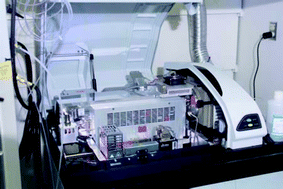Precise ruthenium fission product isotopic analysis using dynamic reaction cell inductively coupled plasma mass spectrometry (DRC-ICP-MS)†
Abstract
99
Tc is a contaminant of interest at numerous nuclear facilities because it is quite mobile in sub-surface environments and is a key contributor to long-term risk. However, as a mono-isotopic fission product, 99Tc is limited in its use as a signature to differentiate between different waste disposal pathways that could have contributed to sub-surface contamination at these facilities. Ruthenium fission-product isotopes are attractive analogues for the characterization of 99Tc sources because of their direct similarity to technetium with regard to subsurface mobility, their large fission yields, and low natural background concentrations. We developed an inductively coupled plasma mass spectrometry (ICP-MS) method capable of measuring ruthenium isotopes in groundwater samples and water extracts of vadose zone sediments. Samples were analyzed directly on a PerkinElmer ELAN DRC II ICP-MS after a single pass through a 1-ml bed volume of Dowex AG 50W-X8 100–200 mesh hydronium-based cation exchange resin. Precise ruthenium isotopic ratio measurements were achieved using a low-flow Meinhard-type nebulizer and long sample acquisition times (150 000 ms). Relative standard deviations of triplicate replicates were maintained at less than 0.5% when the total ruthenium solution concentration was 0.1 ng ml−1 or higher. Further work was performed to minimize the impact caused by mass interferences using the dynamic reaction cell (DRC) with O2 as the reaction gas. Aqueous concentrations of 96Mo and 96Zr, two potential interferents to the analysis of total ruthenium concentration, were reduced by more than 99.7% in the reaction cell prior to injection of the sample into the mass analyzer quadrupole. The DRC was used in combination with mass correction to quantitatively analyze samples containing up to two orders of magnitude more zirconium and molybdenum than ruthenium. The analytical approach documented herein provides an efficient and cost-effective way to precisely measure ruthenium isotopes and quantitate total ruthenium (natural versus fission-product) in aqueous matrixes.
000 ms). Relative standard deviations of triplicate replicates were maintained at less than 0.5% when the total ruthenium solution concentration was 0.1 ng ml−1 or higher. Further work was performed to minimize the impact caused by mass interferences using the dynamic reaction cell (DRC) with O2 as the reaction gas. Aqueous concentrations of 96Mo and 96Zr, two potential interferents to the analysis of total ruthenium concentration, were reduced by more than 99.7% in the reaction cell prior to injection of the sample into the mass analyzer quadrupole. The DRC was used in combination with mass correction to quantitatively analyze samples containing up to two orders of magnitude more zirconium and molybdenum than ruthenium. The analytical approach documented herein provides an efficient and cost-effective way to precisely measure ruthenium isotopes and quantitate total ruthenium (natural versus fission-product) in aqueous matrixes.


 Please wait while we load your content...
Please wait while we load your content...